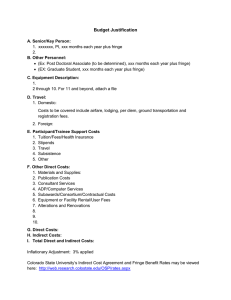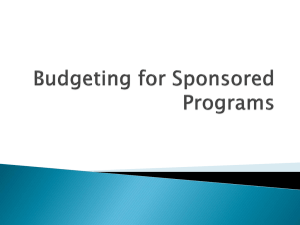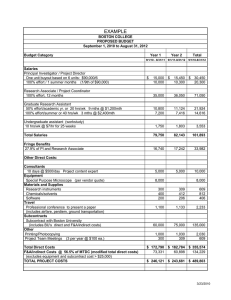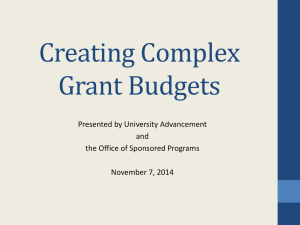Budget Development & Definitions
advertisement
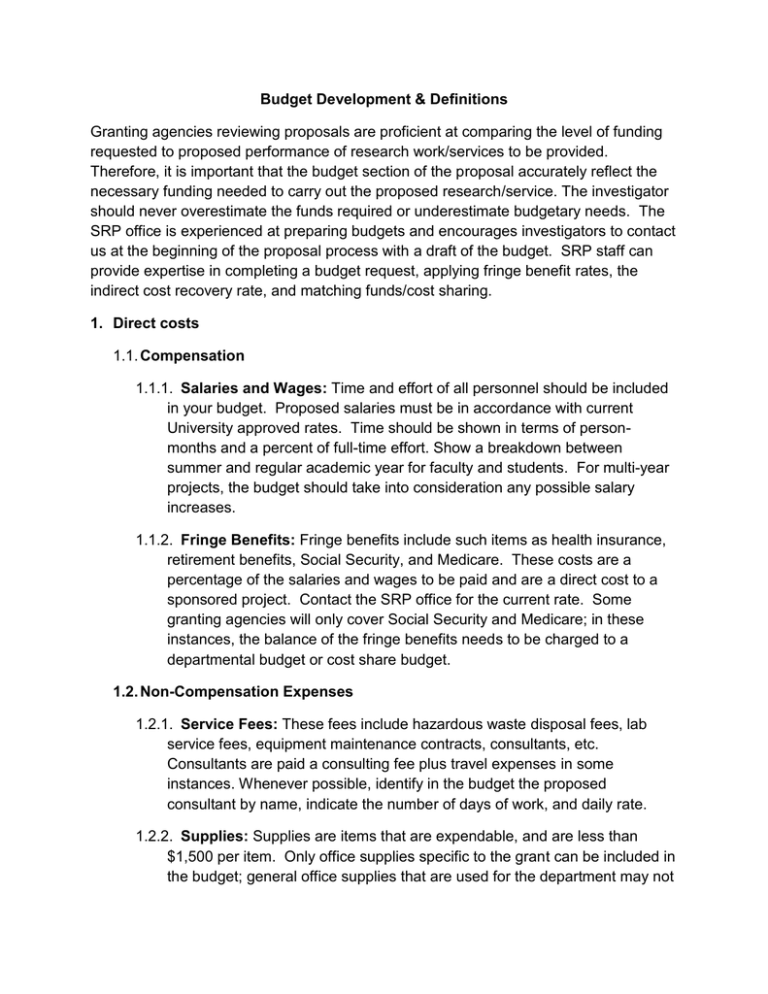
Budget Development & Definitions Granting agencies reviewing proposals are proficient at comparing the level of funding requested to proposed performance of research work/services to be provided. Therefore, it is important that the budget section of the proposal accurately reflect the necessary funding needed to carry out the proposed research/service. The investigator should never overestimate the funds required or underestimate budgetary needs. The SRP office is experienced at preparing budgets and encourages investigators to contact us at the beginning of the proposal process with a draft of the budget. SRP staff can provide expertise in completing a budget request, applying fringe benefit rates, the indirect cost recovery rate, and matching funds/cost sharing. 1. Direct costs 1.1. Compensation 1.1.1. Salaries and Wages: Time and effort of all personnel should be included in your budget. Proposed salaries must be in accordance with current University approved rates. Time should be shown in terms of personmonths and a percent of full-time effort. Show a breakdown between summer and regular academic year for faculty and students. For multi-year projects, the budget should take into consideration any possible salary increases. 1.1.2. Fringe Benefits: Fringe benefits include such items as health insurance, retirement benefits, Social Security, and Medicare. These costs are a percentage of the salaries and wages to be paid and are a direct cost to a sponsored project. Contact the SRP office for the current rate. Some granting agencies will only cover Social Security and Medicare; in these instances, the balance of the fringe benefits needs to be charged to a departmental budget or cost share budget. 1.2. Non-Compensation Expenses 1.2.1. Service Fees: These fees include hazardous waste disposal fees, lab service fees, equipment maintenance contracts, consultants, etc. Consultants are paid a consulting fee plus travel expenses in some instances. Whenever possible, identify in the budget the proposed consultant by name, indicate the number of days of work, and daily rate. 1.2.2. Supplies: Supplies are items that are expendable, and are less than $1,500 per item. Only office supplies specific to the grant can be included in the budget; general office supplies that are used for the department may not be included. Separately list operating supplies, office supplies, research and lab supplies, instructional supplies, postage, faculty research publication costs, duplicating/printing, and subscriptions, and reference books. 1.2.3. Other Miscellaneous Costs: These costs include advertising (for personnel and participants only), utilities, dues, fees, and memberships (for required dues/memberships only). 1.2.4. Travel: Domestic and foreign travel need to be listed separately. Travel needs to include airfare, lodging, meals, ground transportation, parking, and registration fees. Proposals to federal and state agencies need to use the federal per diem rates. 1.2.5. Participant Support: Participant support is for participants and trainees, but not employees. Costs include stipends, per diem, transportation, and other costs related to sponsored conferences, meetings, workshops, and training activities. 1.2.6. Computers and Equipment : Computers and equipment need to be separated between costs below $1,500 per item and costs above $1,500 per item. Each piece needs to be listed individually with a quote or printed cost. In addition, sales tax and freight/shipping need to be listed and added to the cost. 2. Indirect Costs Indirect costs, also called Indirect Cost Recovery, Overhead, or Facilities and Administration (F&A), are costs that are not readily identifiable with individual projects. These costs include the cost of departmental office support, building and equipment use, library services, etc. Indirect costs must be included in all proposal budgets unless the sponsor specifically states they are unallowable. Indirect rates are federally negotiated with each university having an Individual Federal Negotiated Rate Agreement. Gonzaga’s federal negotiated indirect cost rate is 53% of salaries and wages (only). However, some sponsored agencies do not allow this rate and only allow a certain percentage, such as 8% or 10% of total direct costs. The SRP Office staff will help determine the correct rate to use for each sponsor.
